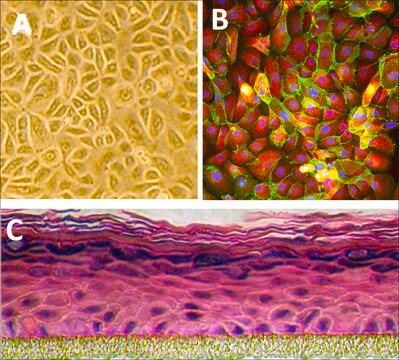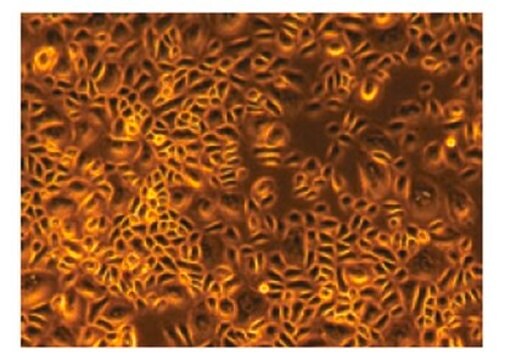102-05N
Human Epidermal Keratinocytes: HEK, neonatal
Synonym(s):
HEK cells
About This Item
Recommended Products
biological source
human neonatal foreskin or adult skin (normal)
Quality Level
packaging
pkg of 500,000 cells
manufacturer/tradename
Cell Applications, Inc
growth mode
Adherent
karyotype
2n = 46
morphology
Epidermal
technique(s)
cell culture | mammalian: suitable
relevant disease(s)
allergies; cancer
shipped in
dry ice
storage temp.
−196°C
General description
Epidermal keratinocytes comprise 90 % of all cells found in the epidermis, the outermost layer of skin. They produce keratin, the intermediate filament, largely responsible for skin’s barrier function. Through their interactions with epidermal melanocytes, keratinocytes obtain melanin and store it as a means of protection from UV radiation.
HEK provide an excellent model system to study many aspects of epithelial function and disease, particularly those related to skin biology and toxicology, as well as HPV infection.
When grown on inserts and provided with the liquid/air interface, HEK can differentiate into a stratified squamous epithelium and serve as a more physiological 3D tissue model for in vitro studies.
Cell Line Origin
Application
Components
Preparation Note
- Primary culture, >500,000 cells in Basal Medium containing 10% FBS & 10% DMSO
- Can be cultured at least 16 doublings
Subculture Routine
Disclaimer
Storage Class Code
11 - Combustible Solids
WGK
WGK 3
Flash Point(F)
Not applicable
Flash Point(C)
Not applicable
Certificates of Analysis (COA)
Search for Certificates of Analysis (COA) by entering the products Lot/Batch Number. Lot and Batch Numbers can be found on a product’s label following the words ‘Lot’ or ‘Batch’.
Already Own This Product?
Find documentation for the products that you have recently purchased in the Document Library.
Customers Also Viewed
Protocols
Storage - Preparation for Culturing - Culturing HEK - Subculturing HEK
3D cell culture protocol for generating epidermal human skin tissue using primary human keratinocytes, dermal fibroblasts, and collagen-coated transwell inserts.
Our team of scientists has experience in all areas of research including Life Science, Material Science, Chemical Synthesis, Chromatography, Analytical and many others.
Contact Technical Service



![5-[bis(2-hydroxyethyl)amino]-6-methyl-2,4(1H,3H)-pyrimidinedione AldrichCPR](/deepweb/assets/sigmaaldrich/product/structures/289/225/e0030cf1-6044-4392-afb4-cfd9fcba4bbc/640/e0030cf1-6044-4392-afb4-cfd9fcba4bbc.png)


